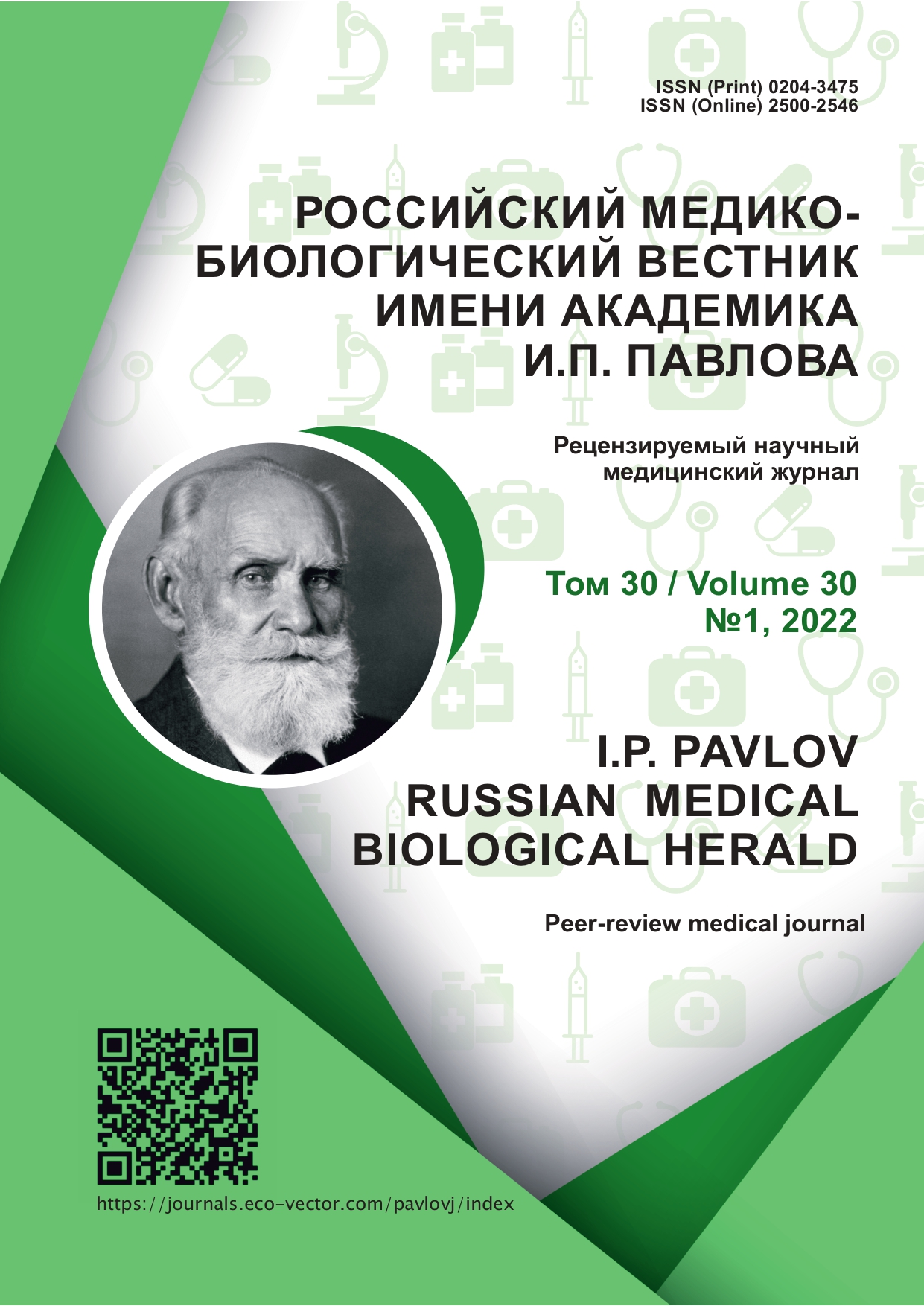Parameters of B-Cell Immunity and Their Diagnostic Significance in Preeclampsia of Different Severities
- Authors: Panova I.A.1, Kudryashova A.V.1, Panashchatenko A.S.1, Rokotyanskaya E.A.1, Malyshkina A.I.1
-
Affiliations:
- Ivanovo Scientific–Research Institute named after V. N. Gorodkov
- Issue: Vol 30, No 1 (2022)
- Pages: 21-28
- Section: Original study
- Submitted: 07.06.2021
- Accepted: 23.11.2021
- Published: 31.03.2022
- URL: https://journals.eco-vector.com/pavlovj/article/view/71253
- DOI: https://doi.org/10.17816/PAVLOVJ71253
- ID: 71253
Cite item
Abstract
INTRODUCTION: Preeclampsia (PE) is a multisystem pathological condition occurring after 20 weeks of pregnancy. According to some scientists, the pathogenetic mechanisms of PE are based on the abnormal response of the mother’s immune system to factors of placental origin.
AIM: To assess the parameters characterizing the condition of B-cells in female patients with PE and to develop the prognostic criterion for the effective treatment of moderate PE.
MATERIALS AND METHODS: A total of 121 women at 24–36 weeks of gestation were examined. The main group included 69 pregnant women with PE in which 36 had moderate PE (group 1a, 18 women with positive effects of PE treatment; group 1b, 18 women with no effect of PE treatment) and 33 had severe PE. The control group included 52 patients with no hypertensive disorders. In the peripheral blood, the relative content of CD19+ and CD20+ В-lymphocytes and their subpopulations, namely, regulatory B-cells (CD20+IL-10+), memory B-cells (CD19+CD27+IgD±), and plasmocytes (СD19+СD20-СD38+), were evaluated by flow cytofluorometry. Statistical analysis was performed using Statistica for Windows 6.0, Microsoft Excel 2010, and MedCalс programs. The diagnostic significance of the studied parameters was evaluated by ROC analysis.
RESULTS: The comparison of all the studied parameters of the content of B-lymphocytes and its subpopulations did not reveal any significant differences in patients with PE of different severities (p > 0.05 in all cases). In the comparative analysis of women with moderate PE exhibiting either positive or no treatment effects, a low level of CD20+В-lymphocytes and a high level of CD19+CD20-CD38+ plasmocytes were noted in the former. In addition, the presence of > 2.8% of CD19+CD20-CD38+ cells in the peripheral blood predicts a positive treatment effect on moderate PE, while ≤ 2.8% predicts an ineffective treatment and aggravation of the PE.
CONCLUSION: The reduction of plasmocytes and absence of treatment effect on moderate PE may be associated with the migration of plasmocytes to the target organs, which leads to the worsening of the immunopathological process during the course of PE. The content of CD19+CD20-CD38+ cells in the peripheral blood can be used to predict treatment efficacy on moderate PE.
Full Text
About the authors
Irina A. Panova
Ivanovo Scientific–Research Institute named after V. N. Gorodkov
Email: ia_panova@mail.ru
ORCID iD: 0000-0002-0828-6547
SPIN-code: 9507-9174
ResearcherId: А-9570-2017
MD, Dr. Sci. (Med.), Professor
Russian Federation, IvanovoAnna V. Kudryashova
Ivanovo Scientific–Research Institute named after V. N. Gorodkov
Email: niimid.immune@mail.ru
ORCID iD: 0000-0002-8501-1029
SPIN-code: 3183-7358
ResearcherId: F-9110-2017
Dr. Sci. (Biol.)
Russian Federation, IvanovoAnna S. Panashchatenko
Ivanovo Scientific–Research Institute named after V. N. Gorodkov
Email: an.zinchencko2017@yandex.ru
ORCID iD: 0000-0002-9175-5016
SPIN-code: 9711-7796
Russian Federation, Ivanovo
Elena A. Rokotyanskaya
Ivanovo Scientific–Research Institute named after V. N. Gorodkov
Email: rokotyanskaya.ea@mail.ru
ORCID iD: 0000-0003-4660-7249
SPIN-code: 4464-5069
ResearcherId: В-3595-2017
MD, Dr. Sci. (Med.)
IvanovoAnna I. Malyshkina
Ivanovo Scientific–Research Institute named after V. N. Gorodkov
Author for correspondence.
Email: anna_im@mail.ru
ORCID iD: 0000-0002-1145-0563
SPIN-code: 7937-9125
ResearcherId: В-5680-2017
MD, Dr. Sci. (Med.), Professor
Russian Federation, IvanovoReferences
- Laule CF, Odean EJ, Wing CR, et al. Role of B1 and B2 lymphocytes in placental ischemia-induced hypertension. American Journal of Physiology. Heart and Circulatory Physiology. 2019;317(4):732–42. doi: 10.1152/ajpheart.00132.2019
- Savel’yeva GM, Sukhikh GT, Serova VN, et al, editors. Akusherstvo: natsional’noye rukovodstvo. 2nd ed. Moscow: GEOTAR–Media; 2015. P. 264. (In Russ).
- Panova IA, Rokotyanskaya EA, Malyshkina AI, et al. Scientific rationale for personalized selection of antihypertensive therapy and management tactics for pregnant women with hypertensive disorders. Obstetrics and Gynecology. 2020;(1):110–8. (In Russ). doi: 10.18565/aig.2020.1.110-118
- Adamyan LV, Artymuk NV, Bashmakova NV, et al. Gipertenzivnyye rasstroystva vo vremya beremennosti, v rodakh i poslerodovom periode. Preeklampsiya. Eklampsiya. Klinicheskiye rekomendatsii (protokol lecheniya). Moscow; 2016. (In Russ).
- Norlander AE, Madhur MS, Harrison DG. The immunology of hypertension. The Journal of Experimental Medicine. 2018;215(1):21–33. doi: 10.1084/jem.20171773
- Panova IA, Malyshkina AI, Kudryashova AV. Synthesis of the matrix metalloproteinases and its inhibitors by peripheral blood phagocytes of women with hypertansion disorders. Journal of Obstetrics and Women’s Diseases. 2015;64(3):26–32. (In Russ). doi: 10.17816/JOWD64326-32
- Ziganshina MM, Shilova NV, Khasbiullina NR, et al. Autoantibodies against endothelial antigens in preeclampsia. Obstetrics and Gynecology. 2016;(3):24–31. (In Russ). doi: 10.18565/aig.2016.3.24-31
- Malsagova AA, Tsakhilova SG, Sakvarelidze NYu, et al. The clinical significance of natural autoantibodies for the diagnosis of preeclampsia. Russian Journal of Human Reproduction. 2020;26(1):90–4. (In Russ). doi: 10.17116/repro20202601190
- Lima J, Cambridge G, Vilas–Boas A. Serum markers of B-cell activation in pregnancy during late gestation, delivery, and the postpartum period. American Journal of Reproductive Immunology. 2019;81(3):e13090. doi: 10.1111/aji.13090
- Saccone G, Berghella V, Maruotti GM, et al. Antiphospholipid antibody profile based obstetric outcomes of primary antiphospholipid syndrome: the PREGNANTS study. American Journal of Obstetrics and Gynecology. 2017;216(5):525.e1-12. doi: 10.1016/j.ajog.2017.01.026
- Chan CT, Lieu M, Toh B–H, et al. Antibodies in the Pathogenesis of Hypertension. BioMed Research International. 2014;2014:504045 doi: 10.1155/2014/504045
- Fettke F, Schumacher A, Costa S–D, et al. B cells: the old new players in reproductive immunology. Frontiers in Immunology. 2014;5:285. doi: 10.3389/fimmu.2014.00285
- Chan CT, Sobey CG, Lieu M, et al. Obligatory Role for B Cells in the Development of Angiotensin II-Dependent Hypertension. Hypertension. 2015;66(5):1023–33. doi: 10.1161/HYPERTENSIONAHA.115.05779
- Hypertension in pregnancy. Report of the American College of Obstetricians and Gynecologists’ Task Force on Hypertension in Pregnancy. Obstetrics & Gynecology. 2013;122(5):1122–31. doi: 10.1097/01.AOG.0000437382.03963.88
Supplementary files











